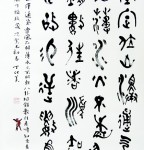| Article Index |
|---|
| Aesthetics & Philosophy About Chinese Calligraphy |
| Search for Beauty |
| Understanding for Beauty |
| All Pages |
There's no single set of criteria for calligraphy - in particular, clearly the hiragana of Heian times is working on a very different basis from the Zen calligraphy of later centuries. Nonetheless, there is some commonality. Such considerations as balance, linework and composition always apply, in some way or other. Calligraphy should be done without hesitation, with speed and confidence, but never easily - one book claims "It is said of one master that he would never accept the work of any pupil who did not get drenched with sweat through the spiritual exertion of writing."
It has always been as rhythmic and musical as Paul Klee's painting. Clearly someone like me, who can't understand the words, sees it in much the same way as I might see an abstract expressionist painting, where the rhythms and linework of a Kline, Pollock or Tobey seem to be pressing much the same buttons. This is of course a category error, in that it neglects the meaning (though these days, some 'calligraphy' is unreadable by Japanese people too), but I can't do too much about that right now.
| < Prev | Next > |
|---|
- 2011-04-07 - Chu Suiliang 褚遂良, one of the Four Great Calligraphers of Early Tang Dynasty
- 2011-01-07 - 文徵明行书《明妃曲》
- 2010-12-20 - Philosophy About Chinese Calligraphy
- 2010-08-10 - Laozi (Lao-tzu, fl. 6th C. BCE)
- 2010-08-08 - The Dragon's Embrace - China's Soft Power Is a Threat to the West
- 2010-04-19 - The Core of Chinese Culture
- 2010-03-12 - Bringing it All Back Home: Chu Teh-Chun at NAMOC













